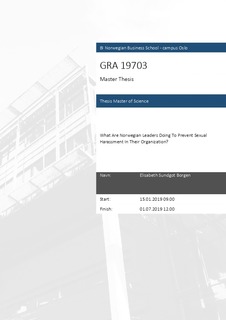| dc.description.abstract | Experiencing sexual harassment (SH) can affect the victim in both human and
organizational terms. In Norway, leaders are obligated to prevent SH from taking
place at their workplace. Despite this, the prevalence of SH at Norwegian workplaces
is remarkably high and knowledge regarding what Norwegian leaders do to prevent
SH in their organization is missing. Therefore, the aim of this study was to examine
what Norwegian leaders are doing to prevent SH in their organization by interviewing
leaders regarding how they define SH, their awareness to the presence of a SH- policy
in their organization and how this policy is established and implemented. In addition,
the question regarding responsibility for the SH- policy and prevention work was
discussed in these interviews.
Through a thematic analysis of the semi- structured interviews with twelve
Norwegian leaders presenting both the academia and big organizations, three primary
categories emerged; clarity vs. “fuzziness”, certainty vs. uncertainty, and finally,
proactive vs. reactive. The findings indicated that the leaders presented a clarity,
however also “fuzziness” towards several important elements in regards to their
prevention work for SH. Also, the leaders` certainty and uncertainty related to their
SH- prevention work was presented. Finally, the leaders were perceived as both
proactive and reactive in regards to actions conducted to prevent SH.
The study indicates that Norwegian leaders have limited knowledge regarding their
organization`s definition of SH and ZT for SH and that they are aware the presence of
their SH- policy, but are lacking knowledge when it comes to the policy`s
establishment and implementation. Finally, the leaders see the responsibility for their
SH- policy and the SH- prevention work as theirs, but had limited knowledge related
to what this prevention work actually includes. In further research, a representative
sample of Norwegian leaders should be asked what they do to prevent SH at their
workplace. Such a study could have led to the drawing of strong conclusions
regarding the question; what are Norwegian leaders doing to prevent SH in their
organization? | nb_NO |
